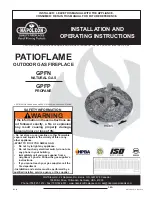
Heat & Glo • EM-42 • 28324 Rev U • 02/07
35
A. Disposal of Ashes
Ashes should be placed in a metal container with a tight-
¿
t-
ting lid. The closed container of ashes should be placed on
a noncombustible
À
oor or on the ground, well away from all
combustible materials, pending
¿
nal disposal. If the ashes
are disposed of by burial in soil or otherwise locally dis-
persed, they should be retained in the closed container until
all embers have thoroughly cooled.
B. Chimney Inspection/Cleaning
Inspect the chimney internally for obstructions and construc-
tion damage. Flue pipe joints and seams must be continu-
ous and mechanically tight.
The chimney should be inspected once every two months
during the heating season.
If creosote has accumulated, it should be removed to reduce
the risk of a chimney
¿
re.
Refer to Figure 11.1 to remove/reinstall termination caps.
Chimney
Remove 4 screws
and lift top pan off.
Cap
Slip
Section
ST375
Square
Termination Cap
Cap
Remove screws,
lift top cover.
Top Cover
TR344/TR342
Round
Termination Cap
Chase
Cap
1. Remove the 4 screws.
2. Remove the screen.
3. Remove the baffle.
TS345/TS345P
Square
Termination Caps
TCT375
Terra Cotta
Termination Cap
Remove 2 screws from
the front and back and
lift the top off.
Cap Top
(Be sure
holes in
cap top
and cap
base are
aligned.)
European Copper Series
Termination Cap
(CT3-King shown)
Cap Base
Remove 8 screws
(9 for King), lift top
cover.
Figure 11.1 Chimney & Termination Cap Cleaning
Fire Risk
Disposal of ashes
• Ashes should be placed in metal container with tight
¿
tting lid.
• Do not place metal container on combustible
surface.
• Ashes should be retained in closed container until all
embers have thoroughly cooled.
WARNING
Fire Risk
Prevent creosote buildup
•
Inspect chimney once every two months during heating
season.
• Remove creosote to reduce risk of chimney
¿
re.
• Ignited creosote is extremely HOT.
WARNING
C. Firebox Refractory
Check
¿
rebox refractory for excessive cracks or gaps. If
cracks exceed 1/4 in. (6 mm) in width the refractory should
be replaced. See Section 12 for replacement information.
Fire Risk
• Inspect
¿
replace refractory annually.
Crumbling, deteriorated refractory can allow
overheating of surrounding materials.
WARNING
Note:
As you use the
¿
replace, expansion and contraction
will cause minor cracking of the refractory. This is normal,
unavoidable, and will not affect the performance of the
¿
replace. If the cracks become large enough that the metal
behind the refractory is exposed or large pieces fall out, the
panels should be replaced.
11
11
Maintenance and Servicing the Fireplace












































